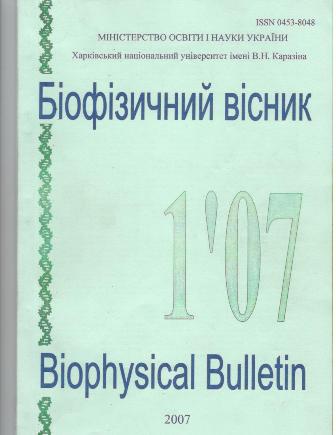Вплив ПОЛ і іонізуючого випромінювання на дезагрегацію тромбоцитів під дією поліпептидного антибіотика граміцидину S
Анотація
Для вивчення взаємодії циклічного поліпептидного антибіотика граміцидину S з клітинними мембранами, з використанням методу турбидиметрії було проведено дослідження впливу модифікації ліпідного бішару мембран тромбоцитів на параметри зв'язування граміцидину S з кров'яними пластинками. У роботі розглянуто процес дезагрегації нативних і γ-опромінених дозами 10-250 Гр тромбоцитів при дії граміцидину S, також вивчено вплив перекисного окислення ліпідів мембран і антиоксидантів на характер розпаду агрегатів тромбоцитів під дією антибіотика при різних температурах в області 8-370С. Показано, що розпушення ліпідного бішару мембран тромбоцитів продуктами перекисного окислення призводить до полегшення вбудовування граміцидину, α-токоферол впливає як развпорядковуюча так і конденсуюча дія на мембрану клітин в залежності від температури середовища. γ -опромінення тромбоцитів in vitro дозами 3-5 Гр призводить до найбільшого розпушення мембран клітин оцінюваного за ступенем і швидкості дезагрегації, спричиненої граміцидином S. Зроблено висновок про провідну роль в механізмі зв'язування граміцидину S з мембраною щільності упаковки ліпідів в бішарі. Результати даної роботи дозволяють використовувати пептидний антибіотик граміцидин S в якості індикатора, чутливого до фазового стану ліпідів біологічних мембран.
Завантаження
Посилання
Al Amush AKhF, Berest VP, Khakl EV, Perskii EE. Vestnik Kharkovskogo natcionalnogo universiteta imeni V.N. Karazina. 2007;5. (in Russian)
Berest VP. Vliianie temperatury na agregatciiu trombotcitov v norme i pri deistvii gamma-oblucheniia. [dissertation]. Kharkov; 1991. 191p. (in Russian)
Born GVR. Nature. 1962;206:927.
Samal AB, Cherenkevich SN, Khmara NF. Agregatciia trombotcitov: metody izucheniia i meekhanizmy. Minsk:Universitetskoe; 1990. 103p. (in Russian)
Berest VP, Gatash SV. Fiziologicheskii zhurnal. 1998;44(5-6):89-94. (in Russian)
Deev AI, Osis IuG, Formaziuk VE. Biofizika. 1983;28(4):629-31. (in Russian)
Marsh SA, Coombes JS. Clin. Appl. Thromb. Hemost. 2006;12(2):169-73.
Vladimirov IuA, Archakov AI. Perekisnoe okislenie lipidov v biologicheskikh membranakh. M.:Nauka; 1972. 252p. (in Russian)
Korolev PN, Bulgakova VG, Polin AN, Korolev NP, Milgram VD. Nauchnye doklady vysshei shkoly, Btologicheskie nauki. 1988;7:31-5. (in Russian)
Katsu T, Kobayashi H, Hirota T, Fujita Y, Sato K, Nagai U. Biochim. Biophys. Acta. 1987;899(2):159-70.
Coorssen J, Rand RP. Studia Biophysica. 1988;127(1-3):53-60.
Latimer P, Wamble F. Appl. Opt. 1982;21(13):2447-55.
Boldyrev AA. Vvedenie v biomembranologiiu. M.:MGU; 1990. 208p. (in Russian)
Berest VP, Gatash SV, Vorobeichik MA. Biofizicheskii vestnik. 1999;4:96-9. (in Russian)
Автори, які публікуються у цьому журналі, погоджуються з наступними умовами:
- Автори залишають за собою право на авторство своєї роботи та передають журналу право першої публікації цієї роботи на умовах ліцензії Creative Commons Attribution License, котра дозволяє іншим особам вільно розповсюджувати опубліковану роботу з обов'язковим посиланням на авторів оригінальної роботи та першу публікацію роботи у цьому журналі.
- Автори мають право укладати самостійні додаткові угоди щодо неексклюзивного розповсюдження роботи у тому вигляді, в якому вона була опублікована цим журналом (наприклад, розміщувати роботу в електронному сховищі установи або публікувати у складі монографії), за умови збереження посилання на першу публікацію роботи у цьому журналі.
- Політика журналу дозволяє і заохочує розміщення авторами в мережі Інтернет (наприклад, у сховищах установ або на особистих веб-сайтах) рукопису роботи, як до подання цього рукопису до редакції, так і під час його редакційного опрацювання, оскільки це сприяє виникненню продуктивної наукової дискусії та позитивно позначається на оперативності та динаміці цитування опублікованої роботи (див. The Effect of Open Access).





